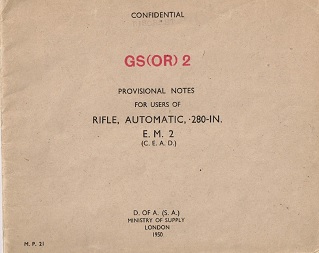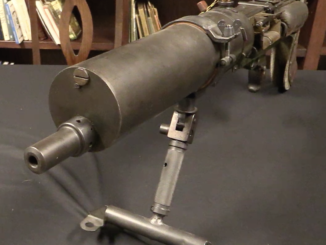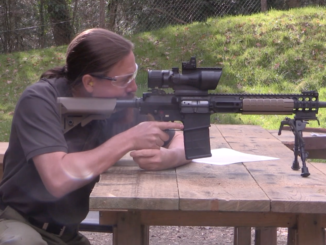I recently got an email from a reader who had scanned the EM-2 manual section from the back of Thomas Dugelby’s EM2 Concept and Design and sent it to me. I thanked him (although I can’t post a scan from a copyrighted book like that), but mentioned that I already have a scan of the manual itself. I went to grab the link, and realized only then that I never actually published that manual, on account of having somehow missed several pages when I scanned it. Still, better to have most of it available than none, so here it is (less pages 4/5, 22/23, and 28/29). The full material is available in Dugelby’s book, although it is out of print and difficult and pricey to find.

For those not familiar, the EM-2 was actually very briefly adopted as the new standard British Army rifle (in .280 Enfield caliber) – Rifle, No. 9 Mk. I in 1951, and then un-adopted before production could begin in a diplomatic acquiescence to the US insistence on NATO use of the 7.62x51mm cartridge. The design is basically a long-stroke gas piston with a bolt and locking mechanism copied from the German G41(W) and G43/K43 rifles. Similar to the Degtyarev system, it uses two flaps in the bolt to lock into matching recessed milled into the receiver walls.
The UK would return to the bullpup style of rifle a couple decades later with the L85 – which (contrary to popular assumption) bears no mechanical or developmental similarity to the EM-2 beyond the bullpup layout. The L85 is in basic terms a bullpup AR-18 – a short-stroke piston and a multi-lug AR-type rotating bolt. For more details on the EM-2 internals, you can take a look at this video I made when I had the opportunity to shoot and disassemble one:




Fantastic work! Thanks very much! Very interesting !
MERRY CHRISTMAS!
Cheers!
“and then un-adopted before production could begin in a diplomatic acquiescence to the US”
Yeah they did that to us and we lost the Arrow ( http://www.fighter-planes.com/info/arrow.htm )
losing the avro arrow was a damn shame. same with the british BAC TSR-2. both times they should have told the americans to go pound sand, and wait a few years…we’d have been begging to make copies of both.
The US had no need to “copy” the Arrow as it had its own heavy, very fast interceptor program around the same time (the North American XF-108), which sadly ended up being cancelled due the perception that such big, expensive interceptors were fast becoming obsolete in the face of the ICBM threat supplanting the long-range bomber threat. I would imagine that this mentality was, in actuality, also the primary factor in the Arrow’s cancellation.
One of the things I appreciate about Forgotten Weapons is how it reveals some of what goes into actually making something as complicated and (hopefully) reliable as a firearm. I think in this day and age few have an appreciation of just how hard it is to actually make something, let alone making something that must function correctly every time, under all kinds of conditions, operated by a sleep-deprived teenager who is so scared they can hardly breathe.
Great find! I really, really wish that Collector’s grade publications would republish this book along with their SPIW book….
I wonder if today all that expensive machining on the receiver would be replaced with some sort of 3D printing, or even the lost-wax casting process ruger uses.
Better to go back to drawing board than to make something that is difficult to manufacture. This rifle really looks like one that was designed by people who had neither practical experience making anything or using a rifle.
The sight and the overall length are about the only 2 things this design had going for it.
I’m not so sure that it was dropped as “a diplomatic acquiescence to the US” or those involved in the project used that as an excuse to drop it to keep themselves out of trouble with their bosses.
The rifle was created by highly skilled and experienced staff at Royal ordinance factory Enfield, they were experts in machining, and not impressed by mere stampings. Having handled one myself it is a beautifully made and designed thing. I think such craftsmen would insist on the thing being tested to destruction, and would not rest until it was 100% reliable and functional before production. There is certainly pathe film of it being test fired frozen, and covered in dirt.
There was a lot of serious scientific work put into developing the .280 round, something were now revisiting in the 6.5 / 6.8 ect.
The same highly skilled and experienced staff at Enfield who went on the develop the SA80?
Regrettably not…
By the time the “Small Arms for the 80s” programme kicked off all the generation of designers that worked on the EM2 were long gone. The other major change was that the procurement agency was no longer staffed by individuals with any practical experience of military firearms design.
The budgets and timescales were also unrealistic given the complexity of what they were trying to do. The layout (bullpup) and the requirement for a full automatic capability were laid down in the staff specification. There was never enough time to design a new weapon from scratch so the design for the AR180 was “borrowed” from Sterling and a bullpup design worked up.
The development process was plagued with problems as a result of lack of time and ignorance of fabrication methods of design. Quite stupid decisions such as the use of a cross bolt safety at the suggestion of a fairly junior Infantry officer were adopted without due consideration. New materials such as plastic composites were selected again without due testing. It has taken a time to work out the kinks..
All this being said however, the current L85A2 is a good rifle. I have carried it on two operational tours and would trust my life to it. It is probably the most accurate standard service rifle on current issue, and although there is a debate over the calibre.. this is another issue.
No military rifle has ever become an instant success.. the Enfield, the Garand, the M16 all went through pretty traumatic birth pangs. Some say “the bearing of a child takes 9 months however many women are assigned” there is also the issue that if you allow development skills to fade, they take time to re-aquire…
Thatcher’s to blame for the frankly sub-par build quality of the A1s, not the engineers at RSAF. A moot point however, since the early 00’s with the introduction of the A2s.
I got the Dugelby book on Inter-Library Loan, then decided not to buy a copy. It’s mostly about the politics behind the rifle, with very little technical information.
I’m still fascinated by the design for some demented reason… but it’s not a good design. It’s complicated, hard to make, and it’s full of little places that look like nice places to trap grunge and then be hard to clean.